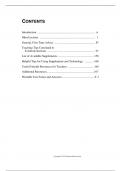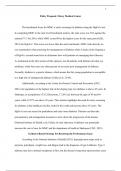CONTENTS
Introduction .................................................................................. iv
M
Mini-Lectures .............................................................................. 1
General, First Time Advice ......................................................... 87
E
Teaching Tips Correlated to
D
Textbook Sections ................................................................... 97
C
List of Available Supplements ................................................... 158
Helpful Tips for Using Supplements and Technology ............. 160
O
Useful Outside Resources for Teachers ..................................... 164
N
Additional Resources...................................................................167
N
Printable Test Forms and Answers...............................................T-1
O
S I
E S
U
R
Copyright © 2014 Pearson Education, Inc.
,INTRODUCTION
Dear Faculty:
Geoffrey Akst, Sadie Bragg, and the Akst/Bragg book team at Pearson are very excited that
M
you will be using Developmental Mathematics through Applications: Basic College
Mathematics and Algebra. We know that whether you are teaching for the first time or the
E
tenth time, you will face many challenges, including how to prepare for class, how to make
the most effective use of your class time, how to present the material to your students in a
D
manner that will make sense to them, how best to assess your students, and the list goes on.
This manual is designed to make your job easier. Inside these pages are words of advice
C
from experienced instructors, specific teaching tips divided by chapter and section, a listing
of valuable resources provided by your fellow instructors, and how-to guides on the use of
O
both student and instructor supplements that accompany this text.
N
We would like to thank the following professors for sharing their advice and teaching tips.
This manual would not be what it is without their valuable contributions.
N
Sheila Anderson, Johnson County Community College
O
Scott W. Beckett, Jacksonville State University
Amanda Bertagnolli-Comstock, Bishop State Community College
S I
Sylvia Brown, Mountain Empire Community College
Pauline Chow, Harrisburg Area Community College
S
James A. Cochran, Kirkwood Community College
E
Lori S. Holdren, Manatee Community College
U
Marilyn Jacobi, Gateway Community College
R
John Jacobs, Massachusetts Bay Community College
Mary Ann (Molly) Misko, Gadsden State Community College
Ellen Mulqueeny, Cleveland State University
Nancy Ressler, Oakton Community College
Sharon Testone, Ph.D., Professor of Mathematics, Onondaga Community College
Beth West, Florida Community College at Jacksonville
Michael Wiemann, Department of Mathematics and Computer Science,
Blue River Community College
Copyright © 2014 Pearson Education, Inc.
,It is also important to know that you have a very valuable resource available to you in your
Pearson Education sales representative. If you do not know your representative, you can
locate him/her by logging on to www.pearsonhighered.com/educator/replocator and typing in
your Zip code. Please feel free to contact your representative if you have any questions
relating to our text or if you need additional supplements.
M
We know that teaching this course can be challenging. We hope that this and the other
resources we have provided will help to minimize the amount of time it takes you to
E
meet those challenges.
D
Good luck in your endeavors!
C
The Akst/Bragg book team
O
N
N
O
S I
E S
U
R
Copyright © 2014 Pearson Education, Inc.
, Instructor’s Resource Manual Developmental Mathematics through Applications 1
Mini-Lecture 1.1
Introduction to Whole Numbers
Objectives:
A Read and write whole numbers.
B Write whole numbers in expanded form.
M
C Round whole numbers.
D Solve applied problems involving reading, writing, or rounding whole numbers.
E
Examples:
D
1. Identify the place value of each digit in the numbers.
C
a) 3,654 b) 265,812 c) 56,203,411
O
2. Write a word name for each number.
a) 325 b) 60,448 N c) 9,542,006
3. Write a number for each word name.
N
a) two hundred fifty-three
b) seven thousand, ninety-eight
O
c) three hundred forty million, one hundred thirty-two
4. What is wrong with the following:
S I
“three hundred and sixty-four”
S
5. When do we use a hyphen when writing whole numbers?
E
Teaching Notes:
U
• Students who do not have English as their first language might need extra help learning the number period
vocabulary such as ones, thousands, millions, billions, etc. Refer them to the Place-value Chart in the
R
textbook.
• Some students who do not have English as their first language are accustomed to using periods instead of
commas as above.
• Many examples of tables are available on the Internet. Request students to obtain copies and ask them to
explain how to read the tables and write the numbers in words.
Answers: 1a) 3-thousands,6-hundreds,5-tens,4-ones, b) 2-hundred thousands,6-ten thousands,5-thousands,8-
hundreds,1-ten,2-ones, c) 5-ten millions,6-millions,2-hundred thousands,3-thousands,4-hundreds,1-tens,1-ones; 2a)
three hundred twenty-five, b) sixty thousand, four hundred forty-eight, c) nine million, five hundred forty-two
thousand, six; 3a) 253, b) 7,098, c) 340,000,132; 4) The word “and” is never used when writing whole numbers.; 5)
A hyphen is used when writing the numbers 21–99, except for numbers ending in zero.
Copyright © 2014 Pearson Education, Inc.





